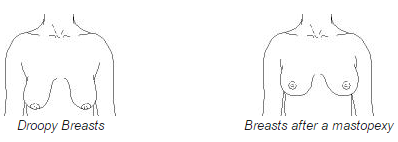Breast uplift
Mastopexy
Peer reviewed by The British Association of Plastic Surgeons (BAAPS)Authored by The British Association of Plastic Surgeons (BAAPS)Originally published 23 Mar 2016
Meets Patient’s editorial guidelines
- DownloadDownload
- Share
- Language
- Discussion
This page has been archived.
It has not been reviewed recently and is not up to date. External links and references may no longer work.
This leaflet is provided by the British Association of Aesthetic Plastic Surgeons, the professional body responsible for the advancement of education and safety in aesthetic plastic surgery.
In this article:
Continue reading below
Mastopexy (up-lifting of droopy breasts)
Droopiness of the breast is a common legacy of motherhood, nursing and the force of gravity taking their toll, and the effect of pregnancy and a distension of the breasts with milk causes the fibrous bands which support the breasts in their youthful shape to break down and the skin to stretch. With the subsequent shrinking the unsupported breasts settle into the stretched skin and gravity pulls them down. Putting on weight and then losing it can have the same effect. So too does the ageing process, which is why women dislike the appearance of their droopy breasts.
What can be done?
Whilst it is not possible to recreate surgically the natural supporting structure of the breast, it is possible to reshape the breast into one which looks more youthful and feels more firm. The operation is called a mastopexy. Pleats of surplus skin are removed from underneath the breast, the breast itself is remodelled into a tighter cone and the nipples are repositioned at a higher level so that they lie at the points of the tightened breasts. Mastopexy can also reduce the size of the areola ( the darker skin surrounding the nipple). If the breasts are too small as well as droopy, their size can be increased during the operation by placing silicone breast implants underneath the tightened breasts. The best results are achieved in women with small sagging breast although breasts of any size can be lifted. The results may not last as long with heavy breasts. Many women seek mastopexy when their families are complete so if you are planning to have further children it may be a good idea to postpone the operation for though there is no risks for future pregnancy and mastopexy does not usually interfere with breast feeding, pregnancy is likely to stretch the breast again and reduce the effectiveness of the procedure.
Droopy breasts before and after mastopexy

Continue reading below
What are the consequences?
This is a good operation to improve the appearance of droopy breasts but you would be left with scars, possibly some numbness of your nipples and you may not be able to breast feed again. Mastopexy can be carried out by a number of different techniques and the scars will differ accordingly. The most common technique involving scars is illustrated below. It may be possible for the operation to be performed with less scars and your surgeon will discuss the possibility of this with you. Usually these scars are fine but they are not invisible and could be noticed by others for example, if you were topless on the beach.
Mastopexy scarlines

What are the limitations?
Because it is not possible to recreate the natural attachment of the breast to the tissues underneath, a mastopexy alone will not greatly increase the fullness of the breasts above the nipples. Fullness above the nipples can be achieved, however, by increasing the size of the breasts with silicone implants. The extra weight of the silicone implants may accelerate the return of the droopiness of the breasts and in any event there is a tendency for the breast to sink downwards as time goes by. You can lessen the rate at which this happens by supporting your breasts in a bra as much as possible.
Continue reading below
What are the risks?
As with any major operation under general anaesthetic, there is a small risk of chest problems particularly if you are a smoker and a small risk of thrombosis of veins in your legs, particularly if you are taking a contraceptive pill. In addition there is a small risk of one or more of the following complications.
Rarely heavy bleeding from the broken blood vessels can occur after the operation, which requires treatment in theatre under another anaesthetic. Occasionally, infection (usually from germs that are lying dormant in the ducts of the breast) can cause part of the wounds to break down which prolongs the healing period and worsens the quality of the final scars.
Some people have an inborn tendency for scars to stretch and some people produce scars which remain thick, red and irritable for a long time. You need to ask your consultant if you are at increased risk of developing this complication.
If silicone implants are used you will need to refer to the leaflet on breast augmentation which will discuss the issue of breast implants and the potential complications in much more detail.
What you should do before the operation
If you smoke, you should stop now. If you are taking the contraceptive pill, change to an alternative method at least six weeks beforehand. If you are overweight, reduce it beforehand.
What you can expect at the time of the operation
This surgery is normally carried out under a general anaesthetic and will often involve an overnight stay in hospital depending on the extent and size of the procedure. Your surgeon will need to mark the size and shape of the breast while you are standing and following the operation you may find that you have two small tubes emerging from each of your breasts so that any collection of blood can drain. These will remain in place for a short period of time. You will be given painkillers for the discomfort you experience in the first few days. Your surgeon may encourage you to wear a firm bra or dressing following surgery which will continue until the stitches are removed some 10 days to 2 weeks later. You should refrain from strenuous physical exercise including swimming, for a month and you will probably require at least two weeks off work. Over the next 6 to 12 months the scars will gradually fade from red to pale. Your surgeon will make every effort to make your scars as inconspicuous as possible but it is important to remember that the scars are extensive and permanent. It is not possible to reshape droopy breasts without significant scars for although the use of breast implants alone will improve the fullness they will not deal with any significant drooping. Breast lift will not last forever and the effects of gravity, pregnancy and weight gain will take their toll, as will time.
Cosmetic surgery is carried out by members of several different organisations and therefore your general practitioner is the best person to advise you on whom you should see.
Content used with permission from the British Association of Aesthetic Plastic Surgeons website: Breast Uplift. Copyright for this leaflet is with the BAAPS.
Disclaimer
This leaflet is designed to supply useful information but is not to be regarded as advice specific to any particular case. It does not replace the need for a thorough consultation and all prospective patients should seek the advice of a suitably qualified medical practitioner. The BAAPS accepts no liability for any decision taken by the reader in respect of the treatment they decide to undertake.
Patient picks for Cosmetic surgery

Surgery and procedures
Nose reduction surgery (rhinoplasty)
This leaflet is provided by the British Association of Aesthetic Plastic Surgeons, the professional body responsible for the advancement of education and safety in aesthetic plastic surgery.
by The British Association of Plastic Surgeons (BAAPS)

Surgery and procedures
Breast augmentation
This leaflet is provided by the British Association of Aesthetic Plastic Surgeons, the professional body responsible for the advancement of education and safety in aesthetic plastic surgery.
by The British Association of Plastic Surgeons (BAAPS)
Continue reading below
Article history
The information on this page is written and peer reviewed by qualified clinicians.
23 Mar 2016 | Originally published
Authored by:
The British Association of Plastic Surgeons (BAAPS)Peer reviewed by
The British Association of Plastic Surgeons (BAAPS)

Ask, share, connect.
Browse discussions, ask questions, and share experiences across hundreds of health topics.

Feeling unwell?
Assess your symptoms online for free
Sign up to the Patient newsletter
Your weekly dose of clear, trustworthy health advice - written to help you feel informed, confident and in control.
By subscribing you accept our Privacy Policy. You can unsubscribe at any time. We never sell your data.